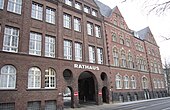Patria WKC
| Patria WKC | |
|---|---|

|
|
| owner |
|
| Introductory year | 1883 |
| Products | Bicycles , motorcycles |
Patria WKC is the brand name for vehicles, especially bicycles and motorcycles , of the Solingen company Weyersberg, Kirschbaum & Cie. (WKC). Today the brand is owned by the Lippe bicycle manufacturer Kleinebenne GmbH .
history
The company was founded in 1883 through the merger of the two long-established traditional companies Gebr. Weyersberg and WR Kirschbaum , both of which had previously only manufactured weapons, mainly bayonets . From then on it was called Weyersberg, Kirschbaum & Cie. (WKC). By 1893 the workforce grew to around 630 employees. From the mid-1890s, the company also manufactured bicycle parts - crank gears, hubs, pedals and chains. In 1898 the first complete bicycle came onto the market under the brand name "Patria" (lat. Patria = fatherland). The company, one of the largest in the city, received the first two telephones in Solingen with the numbers 1 and 2.
In 1897/1898 there was a first crisis in the bicycle industry, which is why half of the workforce was laid off. From then on, the company also switched to the production of other devices such as hair clippers , axes and sugar tusks ( machetes ). Between 1899 and 1901, the company also manufactured a small number of automobiles with single-cylinder engines. Another source confirms the construction period and also states that it was tricars based on motorcycles that could carry a person or luggage between the front wheels.
After overcoming this crisis, WKC produced up to 35,000 bicycles a year until the 1910s; after the First World War , annual production rose to around 100,000 units. This made WKC one of the ten largest bicycle factories in Germany. The workforce at WKC grew to around 1200 employees. However, efforts by the company to get into motorcycle manufacturing failed. In the course of the global economic crisis , the parent company Siegen-Solinger Gussstahl-Aktien-Verein , to which WKC had belonged since 1922, went bankrupt in 1929. By outsourcing individual departments, which later became independent companies, the production of bicycles, weapons and hair clippers at WKC could be continued.
Between 1933 and 1945 the WKC company regained a name for high-quality bare weapons and became the most important saber supplier for the Wehrmacht . During the Second World War , the buildings of the WKC, which had moved from their original address in the city center to the Merscheid district in 1932 , were the target of the English bombing of Solingen and almost all of them were destroyed.
From 1948 to 1951 Patria WKC financed its own cycling team with well-known riders such as Erich Bautz from Dortmund and Oskar Thierbach from Dresden . In 1953 the company, which in the meantime also manufactured mopeds and small motorcycles in addition to bicycles, had to stop production. The weapons division of Weyersberg, Kirschbaum & Cie. produces edged weapons to this day.
Bicycles with the brand name Patria have been manufactured by Ernst Kleinebenne , later Kleinebenne GmbH, in Leopoldshöhe near Bielefeld since 1971 .
WKC building and new town hall
Until 1929 the administration of the company WKC was located in a brick building on Cronenberger Straße in Solingen. It was used by the city administration from 1937, but kept the designation "WKC building". In 2008 a new town hall was built, into which the old listed building was integrated. In the foyer of the new town hall, an exhibition was reminiscent of the WKC company, but it was dismantled in November 2010 to make room for future art exhibitions. A WKC advertising poster from 1900 by Solingen artist Robert Engels can still be seen in the faithfully preserved staircase of the oldest building wing from 1898. Together with the WKC company logo in the wrought-iron banister, the armor, it is a reminder of the building's past.
Individual evidence
- ↑ Production continued at the subsidiary Solinger Axt- und Hauerfabrik, Berg & Co. in Solingen-Ohligs until the 1970s . See page no longer available , search in web archives: militaria-datenbank.com
- ↑ George Nicholas Georgano (Ed.): The Beaulieu Encyclopedia of the Automobile . Volume 3: P-Z . Fitzroy Dearborn Publishers, Chicago 2001, ISBN 1-57958-293-1 (English).
- ↑ Michael Wolff Metternich : 100 years on 3 wheels. German three-lane vehicles through the ages. Neue Kunst Verlag, Munich, ISBN 3-929956-00-4 , p. 283.
- ↑ Erich Otto Seyfert: The German bicycle industry . Diss. Leipzig 1912, p. 88.
- ↑ wkc-solingen.de
- ↑ Imprint. In: patria.net. Retrieved January 19, 2018 .
- ↑ Solinger Tageblatt v. November 19, 2010
literature
- Wilhelm Matthies: History of the Solingen bicycle industry. In: The bone shaker . No. 34 = 2, 2005, ISSN 1430-2543 , pp. 2-6.




